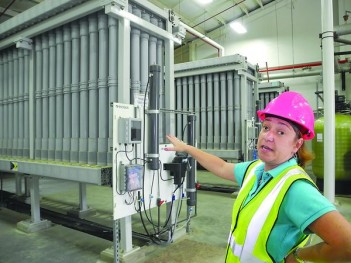
Wheeling water treatment plant employee Danielle Seabright points to the membrane filters that treat the city’s water supply.
WHEELING, W.Va. — In the first true test of its ability to handle a threat to Wheeling’s water supply, the city’s new water treatment plant passed with flying colors, according to Public Works Director Russell Jebbia.
Last week’s discovery of elevated blue-green algae levels on the Ohio River near Pike Island Locks and Dam forced Wheeling to close its river intake and switch over to its backup supply of well water. Although the new plant’s equipment had been through test runs before the $35 million facility in Warwood began producing water in June, it was the first time staff had to take action due to an actual concern about water quality.
By Saturday, local health officials indicated the algae had dissipated sufficiently for people to partake in recreational activities on the river safely. A water conservation order was lifted Sunday, although Jebbia said the plant is still mixing well water with river water as a precaution.
“Everything went very well,” Jebbia said Tuesday. “With the new system that we have, anytime we’re notified there’s a potential problem or something in the river, we can shut the intake off immediately and switch over to our well water, and that’s what we did in this case.”
Officials said the safety of water coming from customers’ taps never was compromised, but direct contact with or consumption of river water with a high concentration of blue-green algae – also known as cyanobacteria – can cause skin and eye irritation and stomach and intestinal illness.
It takes less than a minute for the plant to close the river intake in case of an emergency. That’s about the same amount of time it would have taken at the old plant, but Jebbia said contaminants can be flushed from the new facility’s state-of-the-art membrane filtration system every 25 minutes – a much shorter interval than the old sand filtration method.
The five wells from which Wheeling can draw water can produce a collective 4 million gallons of water per day – only about half the city’s normal daily output using river water. When the reserves in some of the storage tanks began to drop, the city asked customers to refrain from unnecessary usage such as filling swimming pools, washing cars or watering lawns.
“We just weren’t sure how soon we’d be able to start drawing from the river again. … It really wasn’t critical at any time, but we wanted to go ahead and issue the conservation order as soon as possible,” Jebbia said.
Although there were no recordable levels of algae in the plant’s test samples, the city will continue blending well water with river water at least until another round of test samples come back. Well water is harder than river water, but is no less safe to drink, according to Jebbia.
“We always try to err on the side of safety,” he said. “We’re still testing the river water for anything dealing with the algae, and we’ll continue to monitor that until we’re comfortable.”
To read more from The Intelligencer/Wheeling News-Register, subscribe here.





